GMC YUKON HYBRID 2009 Service Manual
Manufacturer: GMC, Model Year: 2009, Model line: YUKON HYBRID, Model: GMC YUKON HYBRID 2009Pages: 94, PDF Size: 0.53 MB
Page 41 of 94
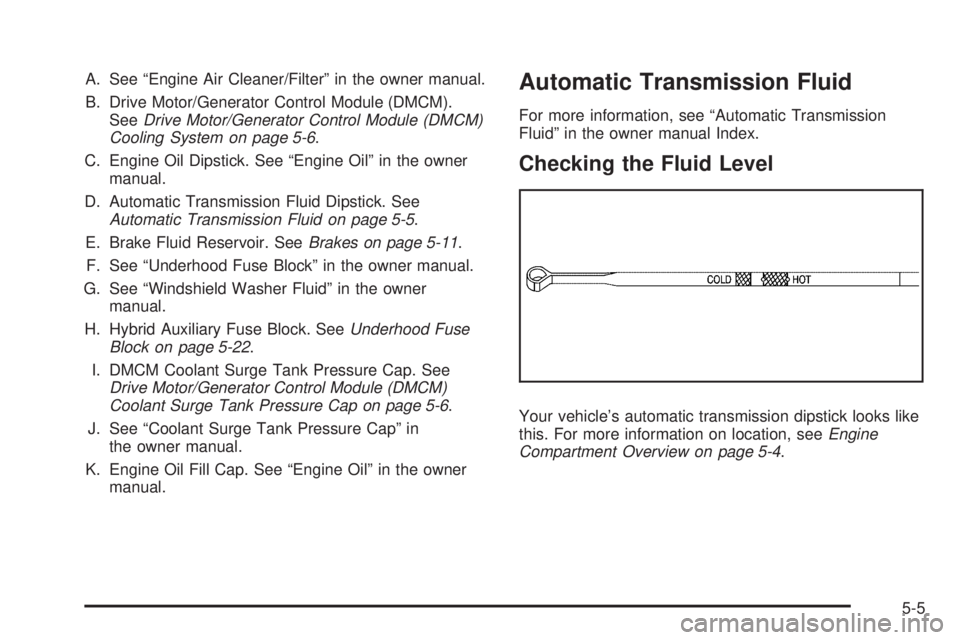
A. See “Engine Air Cleaner/Filter” in the owner manual.
B. Drive Motor/Generator Control Module (DMCM).
SeeDrive Motor/Generator Control Module (DMCM)
Cooling System on page 5-6.
C. Engine Oil Dipstick. See “Engine Oil” in the owner
manual.
D. Automatic Transmission Fluid Dipstick. See
Automatic Transmission Fluid on page 5-5.
E. Brake Fluid Reservoir. SeeBrakes on page 5-11.
F. See “Underhood Fuse Block” in the owner manual.
G. See “Windshield Washer Fluid” in the owner
manual.
H. Hybrid Auxiliary Fuse Block. SeeUnderhood Fuse
Block on page 5-22.
I. DMCM Coolant Surge Tank Pressure Cap. See
Drive Motor/Generator Control Module (DMCM)
Coolant Surge Tank Pressure Cap on page 5-6.
J. See “Coolant Surge Tank Pressure Cap” in
the owner manual.
K. Engine Oil Fill Cap. See “Engine Oil” in the owner
manual.Automatic Transmission Fluid
For more information, see “Automatic Transmission
Fluid” in the owner manual Index.
Checking the Fluid Level
Your vehicle’s automatic transmission dipstick looks like
this. For more information on location, seeEngine
Compartment Overview on page 5-4.
5-5
Page 42 of 94
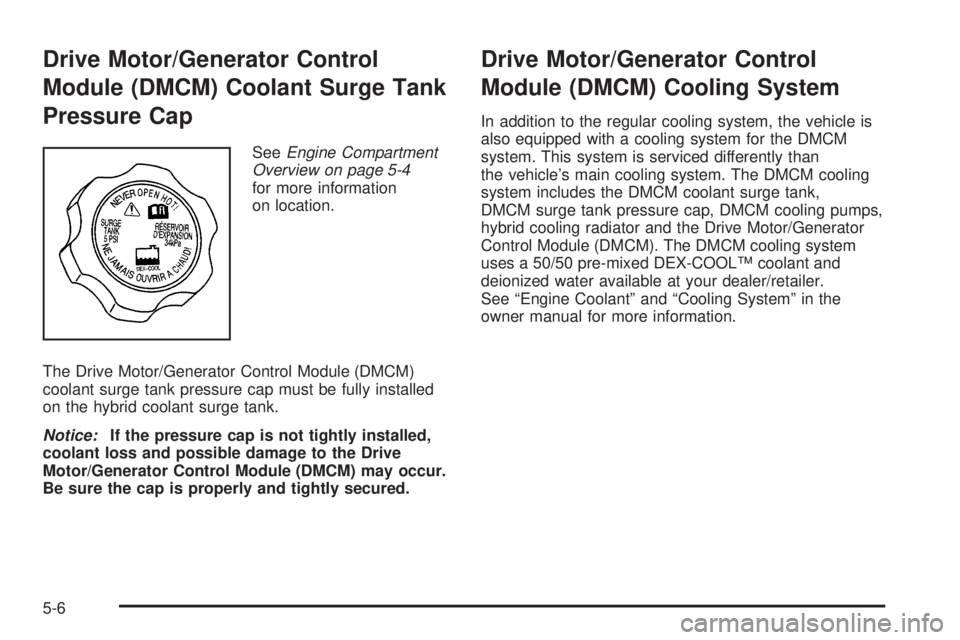
Drive Motor/Generator Control
Module (DMCM) Coolant Surge Tank
Pressure Cap
SeeEngine Compartment
Overview on page 5-4
for more information
on location.
The Drive Motor/Generator Control Module (DMCM)
coolant surge tank pressure cap must be fully installed
on the hybrid coolant surge tank.
Notice:If the pressure cap is not tightly installed,
coolant loss and possible damage to the Drive
Motor/Generator Control Module (DMCM) may occur.
Be sure the cap is properly and tightly secured.
Drive Motor/Generator Control
Module (DMCM) Cooling System
In addition to the regular cooling system, the vehicle is
also equipped with a cooling system for the DMCM
system. This system is serviced differently than
the vehicle’s main cooling system. The DMCM cooling
system includes the DMCM coolant surge tank,
DMCM surge tank pressure cap, DMCM cooling pumps,
hybrid cooling radiator and the Drive Motor/Generator
Control Module (DMCM). The DMCM cooling system
uses a 50/50 pre-mixed DEX-COOL™ coolant and
deionized water available at your dealer/retailer.
See “Engine Coolant” and “Cooling System” in the
owner manual for more information.
5-6
Page 43 of 94
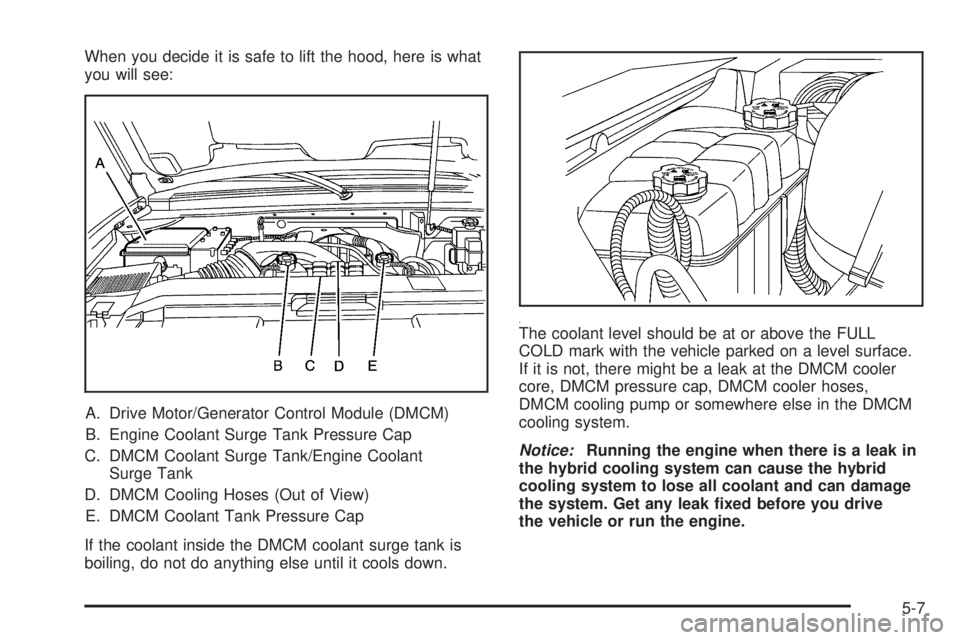
When you decide it is safe to lift the hood, here is what
you will see:
A. Drive Motor/Generator Control Module (DMCM)
B. Engine Coolant Surge Tank Pressure Cap
C. DMCM Coolant Surge Tank/Engine Coolant
Surge Tank
D. DMCM Cooling Hoses (Out of View)
E. DMCM Coolant Tank Pressure Cap
If the coolant inside the DMCM coolant surge tank is
boiling, do not do anything else until it cools down.The coolant level should be at or above the FULL
COLD mark with the vehicle parked on a level surface.
If it is not, there might be a leak at the DMCM cooler
core, DMCM pressure cap, DMCM cooler hoses,
DMCM cooling pump or somewhere else in the DMCM
cooling system.
Notice:Running the engine when there is a leak in
the hybrid cooling system can cause the hybrid
cooling system to lose all coolant and can damage
the system. Get any leak �xed before you drive
the vehicle or run the engine.
5-7
Page 44 of 94
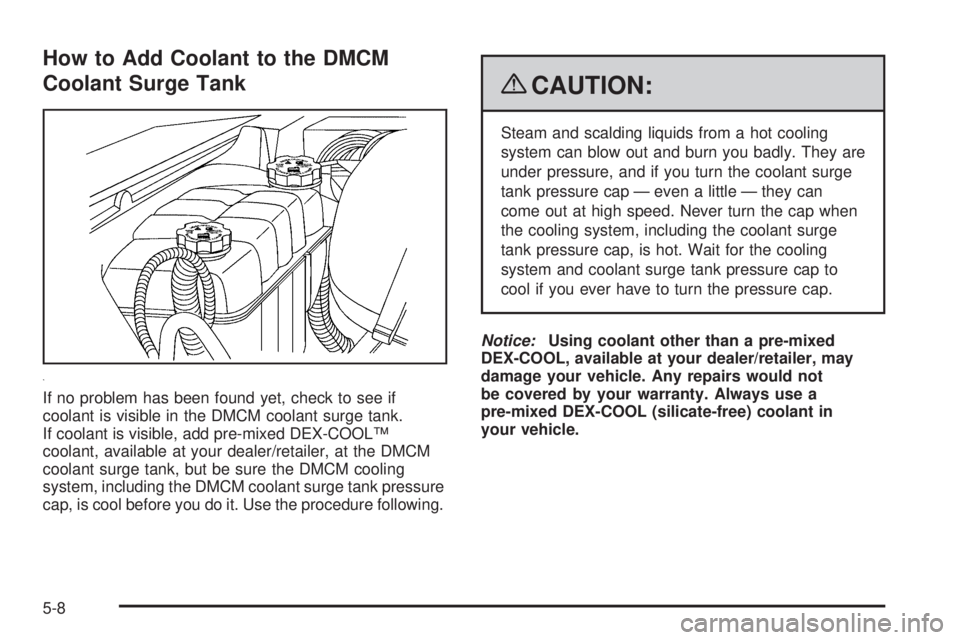
How to Add Coolant to the DMCM
Coolant Surge Tank
If no problem has been found yet, check to see if
coolant is visible in the DMCM coolant surge tank.
If coolant is visible, add pre-mixed DEX-COOL™
coolant, available at your dealer/retailer, at the DMCM
coolant surge tank, but be sure the DMCM cooling
system, including the DMCM coolant surge tank pressure
cap, is cool before you do it. Use the procedure following.
{CAUTION:
Steam and scalding liquids from a hot cooling
system can blow out and burn you badly. They are
under pressure, and if you turn the coolant surge
tank pressure cap — even a little — they can
come out at high speed. Never turn the cap when
the cooling system, including the coolant surge
tank pressure cap, is hot. Wait for the cooling
system and coolant surge tank pressure cap to
cool if you ever have to turn the pressure cap.
Notice:Using coolant other than a pre-mixed
DEX-COOL, available at your dealer/retailer, may
damage your vehicle. Any repairs would not
be covered by your warranty. Always use a
pre-mixed DEX-COOL (silicate-free) coolant in
your vehicle.
5-8
Page 45 of 94
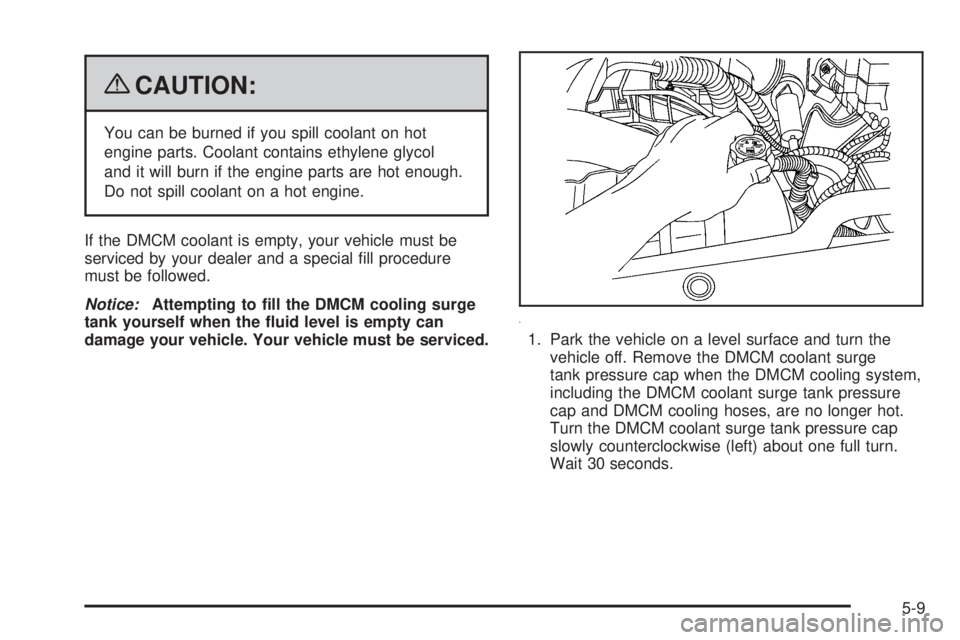
{CAUTION:
You can be burned if you spill coolant on hot
engine parts. Coolant contains ethylene glycol
and it will burn if the engine parts are hot enough.
Do not spill coolant on a hot engine.
If the DMCM coolant is empty, your vehicle must be
serviced by your dealer and a special fill procedure
must be followed.
Notice:Attempting to �ll the DMCM cooling surge
tank yourself when the �uid level is empty can
damage your vehicle. Your vehicle must be serviced.1. Park the vehicle on a level surface and turn the
vehicle off. Remove the DMCM coolant surge
tank pressure cap when the DMCM cooling system,
including the DMCM coolant surge tank pressure
cap and DMCM cooling hoses, are no longer hot.
Turn the DMCM coolant surge tank pressure cap
slowly counterclockwise (left) about one full turn.
Wait 30 seconds.
5-9
Page 46 of 94
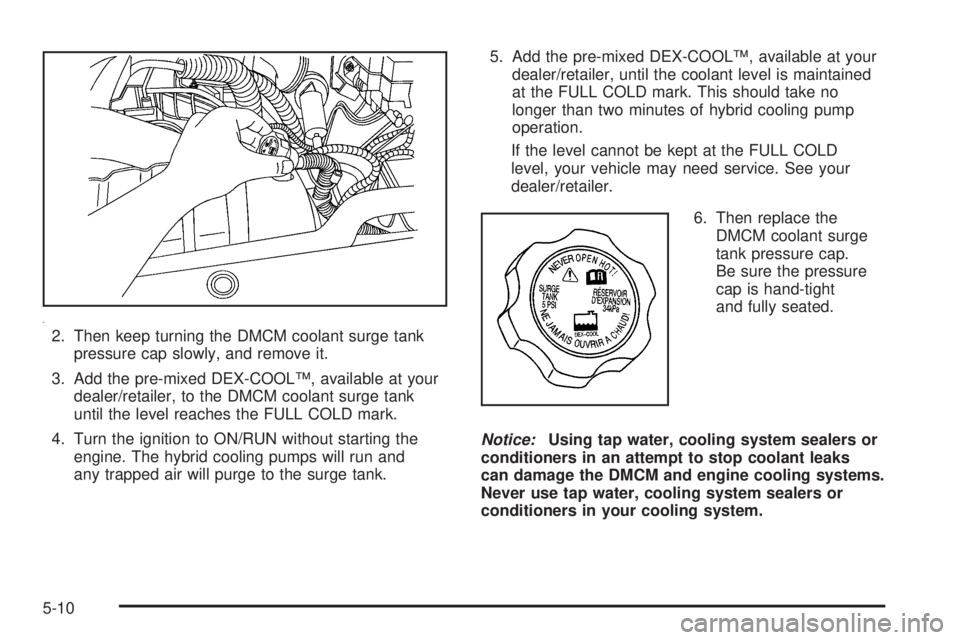
2. Then keep turning the DMCM coolant surge tank
pressure cap slowly, and remove it.
3. Add the pre-mixed DEX-COOL™, available at your
dealer/retailer, to the DMCM coolant surge tank
until the level reaches the FULL COLD mark.
4. Turn the ignition to ON/RUN without starting the
engine. The hybrid cooling pumps will run and
any trapped air will purge to the surge tank.5. Add the pre-mixed DEX-COOL™, available at your
dealer/retailer, until the coolant level is maintained
at the FULL COLD mark. This should take no
longer than two minutes of hybrid cooling pump
operation.
If the level cannot be kept at the FULL COLD
level, your vehicle may need service. See your
dealer/retailer.
6. Then replace the
DMCM coolant surge
tank pressure cap.
Be sure the pressure
cap is hand-tight
and fully seated.
Notice:Using tap water, cooling system sealers or
conditioners in an attempt to stop coolant leaks
can damage the DMCM and engine cooling systems.
Never use tap water, cooling system sealers or
conditioners in your cooling system.
5-10
Page 47 of 94
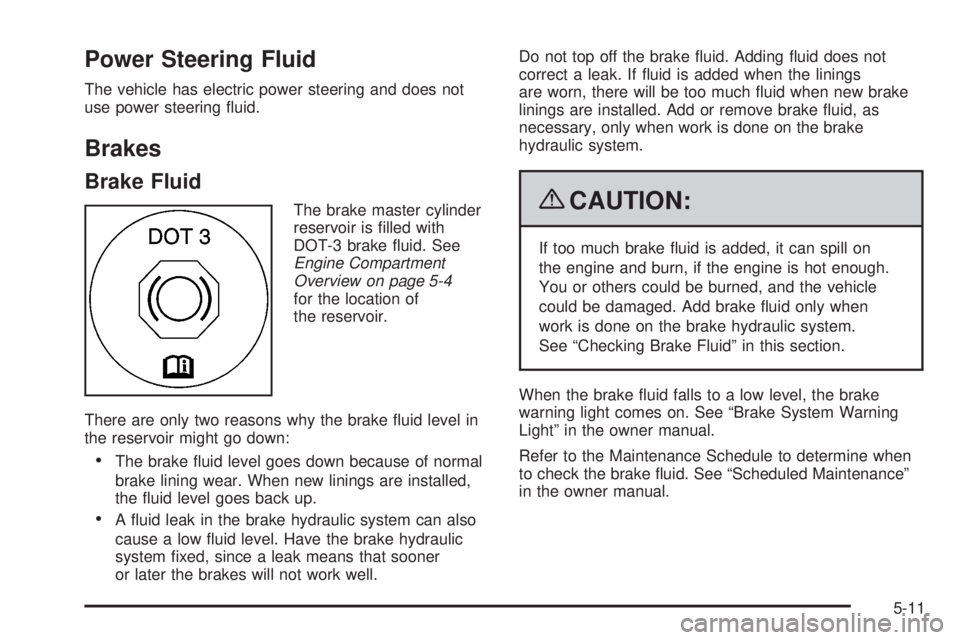
Power Steering Fluid
The vehicle has electric power steering and does not
use power steering fluid.
Brakes
Brake Fluid
The brake master cylinder
reservoir is filled with
DOT-3 brake fluid. See
Engine Compartment
Overview on page 5-4
for the location of
the reservoir.
There are only two reasons why the brake fluid level in
the reservoir might go down:
•The brake fluid level goes down because of normal
brake lining wear. When new linings are installed,
the fluid level goes back up.
•A fluid leak in the brake hydraulic system can also
cause a low fluid level. Have the brake hydraulic
system fixed, since a leak means that sooner
or later the brakes will not work well.Do not top off the brake fluid. Adding fluid does not
correct a leak. If fluid is added when the linings
are worn, there will be too much fluid when new brake
linings are installed. Add or remove brake fluid, as
necessary, only when work is done on the brake
hydraulic system.
{CAUTION:
If too much brake fluid is added, it can spill on
the engine and burn, if the engine is hot enough.
You or others could be burned, and the vehicle
could be damaged. Add brake fluid only when
work is done on the brake hydraulic system.
See “Checking Brake Fluid” in this section.
When the brake fluid falls to a low level, the brake
warning light comes on. See “Brake System Warning
Light” in the owner manual.
Refer to the Maintenance Schedule to determine when
to check the brake fluid. See “Scheduled Maintenance”
in the owner manual.
5-11
Page 48 of 94
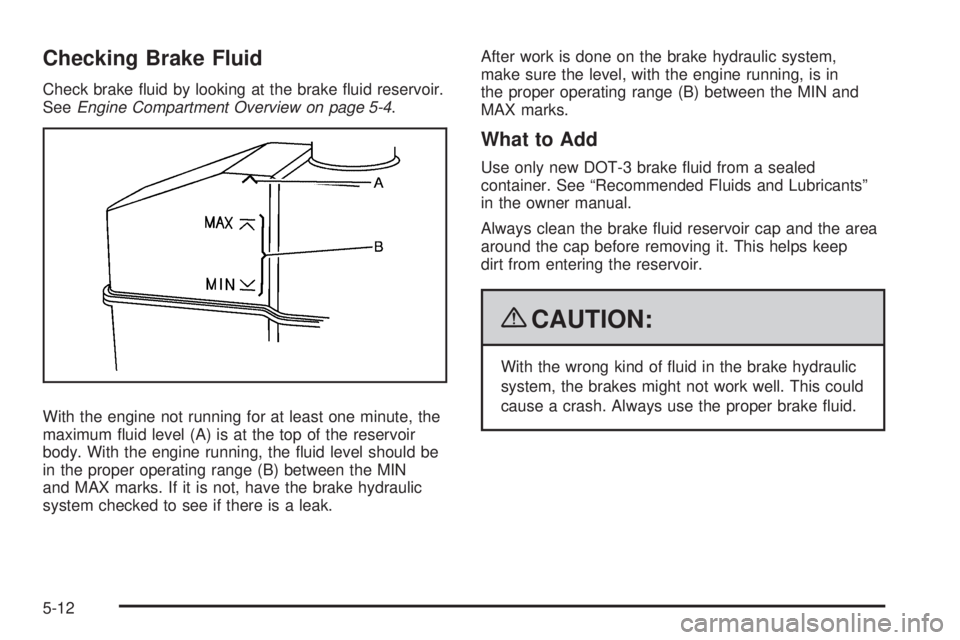
Checking Brake Fluid
Check brake fluid by looking at the brake fluid reservoir.
SeeEngine Compartment Overview on page 5-4.
With the engine not running for at least one minute, the
maximum fluid level (A) is at the top of the reservoir
body. With the engine running, the fluid level should be
in the proper operating range (B) between the MIN
and MAX marks. If it is not, have the brake hydraulic
system checked to see if there is a leak.After work is done on the brake hydraulic system,
make sure the level, with the engine running, is in
the proper operating range (B) between the MIN and
MAX marks.
What to Add
Use only new DOT-3 brake fluid from a sealed
container. See “Recommended Fluids and Lubricants”
in the owner manual.
Always clean the brake fluid reservoir cap and the area
around the cap before removing it. This helps keep
dirt from entering the reservoir.
{CAUTION:
With the wrong kind of fluid in the brake hydraulic
system, the brakes might not work well. This could
cause a crash. Always use the proper brake fluid.
5-12
Page 49 of 94
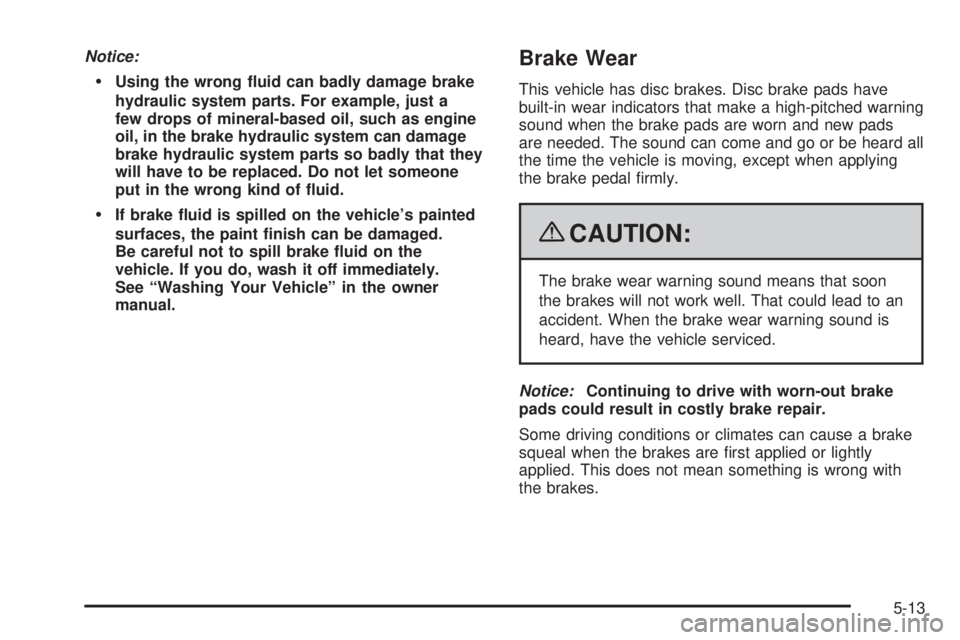
Notice:
Using the wrong �uid can badly damage brake
hydraulic system parts. For example, just a
few drops of mineral-based oil, such as engine
oil, in the brake hydraulic system can damage
brake hydraulic system parts so badly that they
will have to be replaced. Do not let someone
put in the wrong kind of �uid.
If brake �uid is spilled on the vehicle’s painted
surfaces, the paint �nish can be damaged.
Be careful not to spill brake �uid on the
vehicle. If you do, wash it off immediately.
See “Washing Your Vehicle” in the owner
manual.
Brake Wear
This vehicle has disc brakes. Disc brake pads have
built-in wear indicators that make a high-pitched warning
sound when the brake pads are worn and new pads
are needed. The sound can come and go or be heard all
the time the vehicle is moving, except when applying
the brake pedal firmly.
{CAUTION:
The brake wear warning sound means that soon
the brakes will not work well. That could lead to an
accident. When the brake wear warning sound is
heard, have the vehicle serviced.
Notice:Continuing to drive with worn-out brake
pads could result in costly brake repair.
Some driving conditions or climates can cause a brake
squeal when the brakes are first applied or lightly
applied. This does not mean something is wrong with
the brakes.
5-13
Page 50 of 94
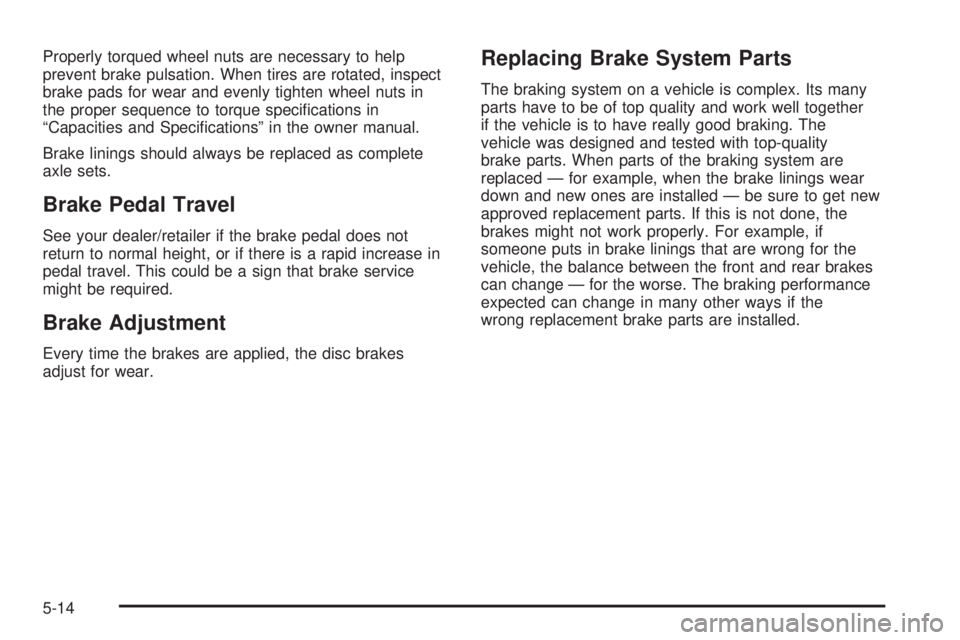
Properly torqued wheel nuts are necessary to help
prevent brake pulsation. When tires are rotated, inspect
brake pads for wear and evenly tighten wheel nuts in
the proper sequence to torque specifications in
“Capacities and Specifications” in the owner manual.
Brake linings should always be replaced as complete
axle sets.
Brake Pedal Travel
See your dealer/retailer if the brake pedal does not
return to normal height, or if there is a rapid increase in
pedal travel. This could be a sign that brake service
might be required.
Brake Adjustment
Every time the brakes are applied, the disc brakes
adjust for wear.
Replacing Brake System Parts
The braking system on a vehicle is complex. Its many
parts have to be of top quality and work well together
if the vehicle is to have really good braking. The
vehicle was designed and tested with top-quality
brake parts. When parts of the braking system are
replaced — for example, when the brake linings wear
down and new ones are installed — be sure to get new
approved replacement parts. If this is not done, the
brakes might not work properly. For example, if
someone puts in brake linings that are wrong for the
vehicle, the balance between the front and rear brakes
can change — for the worse. The braking performance
expected can change in many other ways if the
wrong replacement brake parts are installed.
5-14